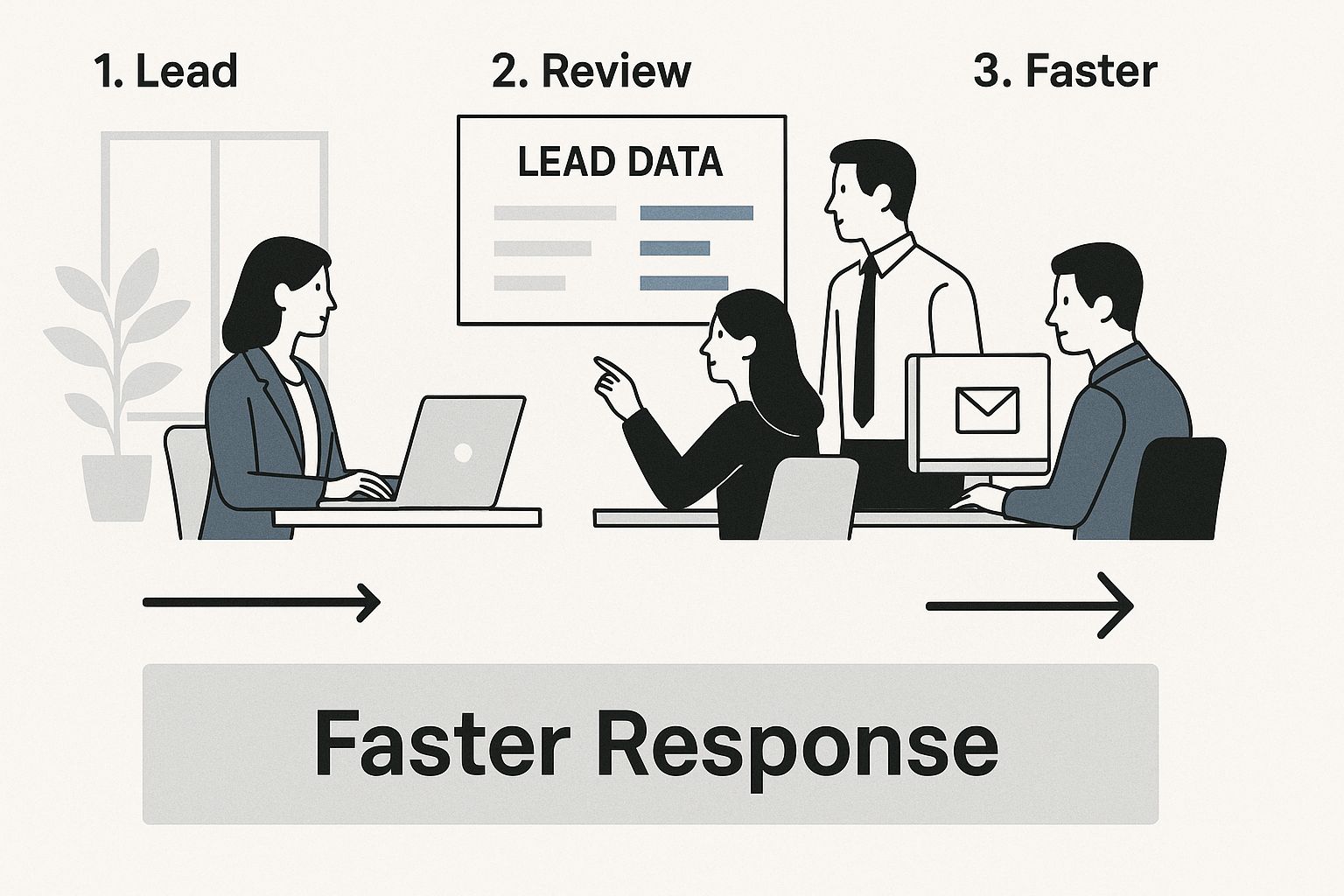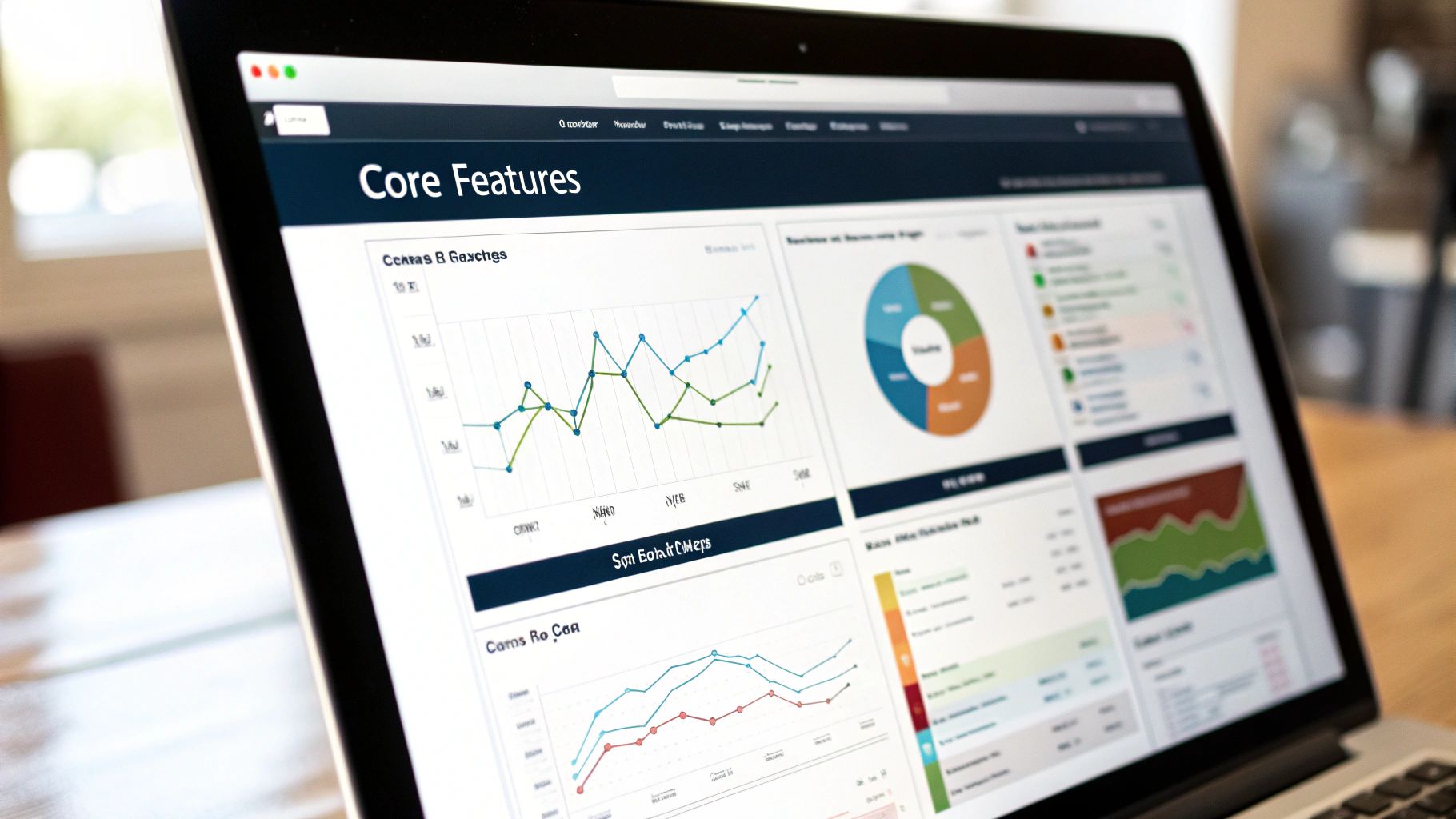Lead Distribution Software: Boost Sales with Easy Setup
Making Sense of Lead Distribution Software (Without the Jargon)
Imagine you're running a bustling pizza place. Orders come in from everywhere – phone calls, online orders, walk-ins. Without a system to get each order to the right cook, you'll have chaos: misplaced toppings, cold pizzas, and frustrated customers. Lead distribution software does for your sales team what that system does for your kitchen. It acts like a smart traffic controller, making sure each lead gets to the right salesperson at the right moment.
This isn't just about tidying up your inbox; it's about making your whole sales process more efficient. Think of it like matching chefs to orders. You wouldn't ask a pastry chef to whip up a deep-dish pizza, would you? Lead distribution software ensures that leads for specific products or services reach the salesperson best suited to handle them. This targeted approach leads to quicker responses, more personalized interactions, and, ultimately, more closed deals.
Understanding the Role of CRM
The image below offers a simplified view of customer relationship management (CRM), a core component of many lead distribution systems:
This visual shows the key areas where CRM, and by extension lead distribution, affects a business. It highlights how managing customer interactions well can influence everything from marketing and sales to customer service. These systems create a more unified and efficient approach to managing the entire customer journey. The growing importance of this technology is clear: The lead generation software market – a vital part of lead distribution – has seen significant growth worldwide.
In 2024, this market was valued at $5.39 billion and is projected to reach $5.92 billion in 2025, a 10.0% compound annual growth rate (CAGR). Discover more insights about the lead generation software market.
Effective lead distribution isn't just a tech upgrade; it's a strategic move that helps sales teams work smarter, not harder. Automating lead routing and tracking frees up salespeople to do what they do best: building relationships and closing deals. This makes the sales process more efficient and improves team morale.
How Lead Distribution Software Actually Works Behind the Scenes
Think of lead distribution software as a highly efficient traffic controller for your sales team. When a new lead comes in—maybe they filled out a form on your website or downloaded a resource—this software steps in to direct them to the right salesperson. It's like a digital matchmaker, ensuring the best possible fit between lead and sales rep.
Imagine a busy restaurant on a Friday night. Instead of a chaotic free-for-all, the host or hostess carefully guides each party to the appropriate table, considering factors like party size and server availability. Lead distribution software does the same thing for your leads, ensuring they are "seated" with the salesperson best equipped to handle their needs.

The infographic above visualizes this process. See how leads are analyzed and efficiently routed to the right team members. This quick response time is critical. Just like a diner is happier being seated promptly, a lead is more likely to engage with a business that responds quickly.
Understanding Routing Algorithms
Now, let's peek behind the curtain to see how these "digital matchmakers" actually work. Lead distribution software uses various routing algorithms—essentially, sets of rules—to determine where each lead should go.
-
Round-robin distribution is like dealing cards. Leads are assigned to sales reps one after another in a rotating sequence. This ensures an even spread of leads across the team.
-
Weighted distribution adds a layer of strategy. Imagine a poker game where some players have more chips than others. Similarly, leads are assigned based on factors like a salesperson's experience, past performance, or area of expertise. This approach prioritizes connecting high-value leads with your top performers.
-
Skills-based routing ensures the right expert handles the right lead. Think of a hospital emergency room. A patient with a broken bone wouldn't be seen by a cardiologist. Similarly, skills-based routing directs leads to sales reps with the specific skills and knowledge needed to address their particular needs. If a lead expresses interest in a specific product or service, they'll be connected with the sales rep who specializes in that area.
Tracking and Automation
Lead distribution software doesn't just distribute leads—it also meticulously tracks their progress. Every interaction, from the initial contact to the final sale (or lost opportunity), is recorded and analyzed. This detailed history provides valuable insights into what's working and what could be improved, empowering sales managers to fine-tune their strategies.

The screenshot above shows an example of lead distribution software integrated with a CRM platform. See how clearly the leads are organized and tracked. This visibility allows sales teams to manage their pipeline effectively, leading to increased productivity and better conversion rates.
To further boost efficiency, many platforms automate key follow-up tasks. This might include sending personalized emails, scheduling reminders for sales reps to make calls, or even sending targeted text messages. By automating these routine tasks, sales reps can free up their time to focus on what they do best: building relationships and closing deals.
Let's look at some key features in a table format:
Lead Distribution Features That Drive Results
Essential features that separate effective lead distribution systems from basic routing tools
| Feature | How It Works | Business Impact | Implementation Priority |
|---|---|---|---|
| Round Robin | Distributes leads sequentially to each sales rep. | Ensures even lead distribution across the team. | High |
| Weighted Distribution | Assigns leads based on rep experience, performance, or other criteria. | Prioritizes high-value leads to top performers. | High |
| Skills-Based Routing | Routes leads based on rep specializations. | Connects leads with the most qualified sales rep. | High |
| Lead Tracking | Records every interaction with a lead. | Provides insights into lead behavior and sales performance. | High |
| Automated Follow-up | Automatically sends emails, reminders, and other communications. | Frees up sales reps' time and ensures timely follow-up. | High |
| Real-time Notifications | Alerts reps instantly when new leads are assigned. | Enables immediate engagement with hot leads. | Medium |
| Reporting & Analytics | Provides data on lead source, conversion rates, and other key metrics. | Helps optimize lead distribution strategies and improve sales performance. | Medium |
This table summarizes some core features to consider when evaluating lead distribution software. Prioritizing these features ensures you choose a solution that can truly transform your sales process.
Why Sales Teams Are Switching to Automated Lead Distribution

The business world is constantly evolving, and sticking with manual lead management is like trying to navigate a busy city with an outdated map. You might eventually get there, but you'll miss out on opportunities and waste valuable time. That's why smart sales teams are adopting automated lead distribution. It's no longer a luxury—it's a necessity for keeping up.
Today's customers expect instant responses. Think about your own experiences: if you fill out a form online, you want to hear back quickly. If a company takes too long, you're likely to move on to a competitor who can provide a faster response. Manual lead assignment simply can't match that speed. Plus, constantly sorting leads keeps your sales team bogged down with administrative tasks, pulling them away from what they do best: selling.
The Benefits of Automation
Automated lead distribution software works like a highly efficient traffic controller, directing each lead to the right salesperson instantly. This "traffic controller" considers factors like a salesperson's area of expertise, current workload, and assigned territory.
This targeted approach has some major advantages:
- Faster Response Times: Leads are contacted quickly, keeping them engaged and preventing them from cooling off.
- Improved Conversions: Connecting leads with the most qualified salesperson increases the likelihood of a sale.
- Happier Sales Teams: Salespeople can focus on building relationships and closing deals, not on tedious admin work.
This switch to automation also unlocks valuable data. Imagine having a clear dashboard that shows you exactly how leads are flowing through your sales pipeline – where they come from, how they progress, and where they might get stuck. That's the kind of visibility you gain with lead distribution software.
By tracking every interaction, you can identify what's working and what needs improvement. For instance, you might discover that leads from a specific marketing campaign convert at a higher rate, or that certain sales reps have a knack for closing particular types of deals. This data-driven insight empowers you to fine-tune your strategies and maximize your ROI.
Market Trends and Growth
The growing need for efficient lead management is reflected in the booming lead distribution software market. This isn't a standalone trend – it's part of a larger movement toward automating sales and marketing processes. In fact, the global lead management market is projected to reach $34.62 billion by 2032, expanding at a 7.6% CAGR. This significant growth highlights the fact that effective lead management is no longer a "nice-to-have" but a critical component of success. Discover more insights about the lead management market. Want to learn more about the link between CRM and lead generation? Check out our guide. This shift towards automation is transforming the sales landscape, equipping businesses to connect with customers more effectively and achieve sustainable growth.
Real Success Stories Across Different Business Types
Lead distribution software isn't a one-size-fits-all solution. Its real power lies in how it adapts to the specific needs of different industries. Let's see how businesses are using this technology to get real results.
Real Estate: From Missed Opportunities to Instant Connections
Sarah, a real estate broker, was struggling with a familiar problem: missed leads. While she was busy showing properties, potential buyers' inquiries were piling up in her inbox. By the time she got around to responding, those valuable leads had often moved on to other agents. Frustrated and losing business, Sarah decided to try a lead distribution system. Now, the moment a potential buyer submits an inquiry, the system instantly connects them with an available agent based on things like location, price range, and expertise. This immediate response has dramatically boosted her lead conversion rate and made her clients much happier.
Imagine a potential buyer inquiring about a luxury condo downtown. With the lead distribution system, that lead is instantly routed to an agent who specializes in high-end properties in that area. The agent can connect with the buyer immediately, answer their questions, and even schedule a showing. No more lost opportunities!
Insurance: Matching Expertise to Client Needs
Mike runs an insurance agency. He realized treating all leads the same wasn’t working. Leads for auto coverage, for example, need a different approach than leads for life insurance. His solution was a lead distribution system that routes inquiries to specialists based on the type of insurance the lead is interested in. Now, auto insurance leads go straight to agents with experience in that area, while life insurance leads go to advisors specializing in financial planning. This more personalized approach has led to happier customers and a noticeable increase in closed deals.
Think of it like this: you wouldn't go to a podiatrist for a heart problem. The same principle applies to insurance. Matching leads with specialized agents ensures a more tailored and effective consultation.
Healthcare: Connecting Patients with the Right Specialists
In a busy healthcare practice, making sure patients quickly connect with the right specialist is essential. Lead distribution software streamlines this process. A patient inquiring about a skin condition, for example, is automatically routed to the dermatology department. This eliminates delays and significantly improves the patient experience. It also frees up administrative staff to focus on providing quality care.
This kind of targeted routing is like having a highly efficient receptionist who instantly knows exactly where each patient needs to go. It saves time, reduces frustration, and improves the overall quality of care.
Financial Services: Managing Leads Across Service Areas
Financial advisors often work with clients spread across different regions. Lead distribution software helps by routing leads based on geographic location, ensuring the most appropriate advisor receives the inquiry. This localized approach helps advisors build stronger relationships with potential clients in their area, building trust and ultimately leading to more new clients.
Imagine a financial advisor based in Chicago receiving a lead from someone in Los Angeles. With lead distribution software, that lead would automatically be routed to an advisor in the Los Angeles area, ensuring a more personalized and effective connection.
To illustrate this in action, let's look at how a popular CRM like HubSpot uses lead distribution software:

The visual layout clearly displays important information like contact details, where the lead came from, and which sales rep is assigned. This makes lead management much more efficient and promotes teamwork.
To better understand how different businesses tailor lead distribution, take a look at the table below:
Industry-Specific Lead Distribution Approaches: How different businesses customize their lead distribution to match unique customer needs and sales processes
| Business Type | Main Challenge | Distribution Strategy | Key Results |
|---|---|---|---|
| Real Estate | Lost leads due to slow response times | Instant routing based on location, price range, and agent expertise | Increased lead conversion rates, higher client satisfaction |
| Insurance | Generic lead handling leading to missed opportunities | Routing based on product interest (auto, life, etc.) to specialized agents | More personalized consultations, increased customer satisfaction, more closed deals |
| Healthcare | Connecting patients with the right specialist efficiently | Routing based on patient's described symptoms or medical needs | Improved patient experience, reduced administrative burden |
| Financial Services | Managing leads across different geographic regions | Routing leads based on location to the closest or most appropriate advisor | Stronger client relationships, higher client acquisition rates |
As you can see, lead distribution software is incredibly flexible. By automating the routing and assignment of leads, businesses of all types can improve efficiency, convert more leads, and create happier customers.
The Transformation You Can Expect From Day One
Imagine swapping your old, clunky bicycle for a sleek, high-performance sports car. That's the kind of upgrade you can expect when you implement lead distribution software. Suddenly, a journey that felt like an uphill battle becomes a smooth, efficient ride.
But what tangible changes can you anticipate? First, kiss those lost leads goodbye. Every single inquiry—whether it comes through a website form, a phone call, or a social media message—is automatically captured and logged. No more leads vanishing into the abyss of overflowing inboxes or forgotten sticky notes.
This newfound organization brings a sense of balance to your sales team. Your top performers are no longer overwhelmed with a mountain of leads while others twiddle their thumbs. The system intelligently distributes leads based on several factors, including availability, expertise, and even territory. This ensures that everyone on your team contributes effectively.
It also means dramatically faster response times. What used to take hours can now be accomplished in mere minutes. Salespeople get instant notifications with all the essential information they need to engage prospects meaningfully.
Furthermore, lead distribution software provides a clear window into your sales pipeline. You finally have a crystal-clear view of which strategies are attracting the most qualified leads and which sales reps are knocking it out of the park. This data empowers you to refine your approach, replicate what's working, and address any roadblocks slowing you down. For more insights on automating your lead generation, check out this helpful resource: How To Automate Lead Generation. It's also interesting to note the significant growth projected for the software distribution market. By 2025, it's expected to reach $147.4 billion, and by 2035, a whopping $536.2 billion at a 13.8% CAGR. Explore the future of software distribution.
Immediate Impacts on Your Sales Process
From the moment you switch on your lead distribution software, you'll see several key improvements:
-
Lead Capture Automation: Picture a tireless virtual assistant diligently logging and assigning every lead, eliminating manual data entry and reducing the risk of human error. That's what lead capture automation does for you.
-
Optimized Lead Routing: Leads are directed to the salesperson best suited to handle them based on expertise, availability, and territory. This precise targeting greatly increases the chances of conversion.
-
Faster Response Times: Sales reps receive instant notifications, allowing them to connect with prospects while their interest is still hot. Think about how much more receptive you are to a prompt response compared to a delayed one.
-
Improved Sales Team Efficiency: By automating administrative tasks, your sales team can spend more time building relationships and closing deals, boosting overall productivity.
-
Increased Sales Performance: With better lead management and a more focused sales approach, you can expect a significant boost in closed deals and overall revenue.
These benefits build on each other over time, creating a more streamlined, efficient, and ultimately, more profitable sales process. This shift empowers your team to work smarter, not harder, and achieve greater success. It's more than just a technology upgrade; it's a fundamental change in how your sales team operates, leading to tangible, positive outcomes. Implementing lead distribution software sets the stage for sustained growth and improved performance across the board.
Avoiding Common Mistakes That Derail Implementation
Let's talk about some common worries people have about lead distribution software. Many business owners think their operations are too small to benefit. Ironically, smaller businesses often see the biggest improvements. Eliminating manual tasks, which can eat up precious time and resources, makes a huge difference for them.
Another misconception? That this type of software makes sales impersonal. Actually, it's quite the opposite. By automating admin work, lead distribution software frees up your sales team to build real relationships. They can spend more time understanding what prospects need and offering personalized solutions, instead of messing around with spreadsheets.
Overcoming the Fear of Technology
Some business owners hesitate, thinking they need a computer science degree to use this software or that it'll turn their current processes upside down. This just isn't the case anymore. Modern lead distribution software, like LeadSavvy Pro, is designed to be easy to use. Intuitive interfaces and readily available support make setup and integration pretty simple, even for non-technical users. These systems are made to work seamlessly with your existing CRM and marketing tools, minimizing disruptions.
For example, we spoke to a small business owner who was initially nervous about the technical side of things. They were surprised by how easy LeadSavvy Pro was to set up, getting it running in hours, not days, and seeing the benefits of automated lead routing right away.
Learning From Others' Experiences
Talking to business owners who are already using lead distribution software is incredibly valuable. Many had the same initial concerns: cost, complexity, and potential workflow interruptions. But after using the software, they realized these fears were mostly unfounded. In fact, many wish they'd started using it sooner. The improved efficiency, sales growth, and happier sales teams made the investment worthwhile.
These conversations often uncover key insights:
-
Start Small, Scale Up: There's no need to use every feature right away. Start with the core functions that address your immediate needs. You can always add more later.
-
Prioritize Training: Make sure your team knows how to use the software effectively. This ensures a smooth transition and helps you get the most out of automation.
-
Choose the Right Partner: Find a vendor with excellent support who gets your specific business challenges. A good partner can guide you through the implementation process and provide ongoing help.
By learning from others, you can sidestep common problems and ensure your lead distribution software implementation goes smoothly. The key is to address your concerns directly, do your research, and choose a solution that matches your goals.
Your Roadmap to Choosing and Implementing the Right Solution
Picking the right lead distribution software can be a bit like finding a needle in a haystack, but with a little direction, the process becomes much clearer. It's all about understanding what you need and having a solid plan. This guide will walk you through choosing and implementing a solution that works perfectly for your business.
Assess Your Current Situation
Before you jump into software demos, it's important to understand your current lead flow. Think of it like taking inventory before you go grocery shopping. How many leads are you getting daily or weekly? How quickly are you responding to them? Knowing these baseline metrics helps you pinpoint areas for improvement and choose a system that solves your specific challenges.
Also, consider how your sales team is structured. Do you have teams specializing in different products or customer types? Are your sales reps spread out geographically? These factors influence what features you’ll need. For example, if you have specialized teams, skills-based routing might be important. If your team is geographically dispersed, you might need location-based routing. You might be interested in: Lead Management Software: Free Options and Considerations.
Key Features to Consider
Knowing which features are must-haves and which are just nice extras is key. Here's a simple breakdown:
- Essential Features: Think of these as the foundation of a house. They include real-time lead routing, automated notifications, lead tracking, CRM integration, and reporting capabilities. These core functions boost efficiency and provide valuable data.
- Nice-to-Have Features: These are like the upgrades – things like a fancy kitchen or a finished basement. They include advanced analytics, lead scoring, and custom integrations with other marketing automation tools. While helpful, they might not be essential, especially if you're just starting out.
Pricing is another important factor. Some solutions charge per user, others have tiered pricing based on features or the number of leads you handle. Choose the model that fits your budget and how you plan to grow.
Demystifying Vendor Demos
Demos are your chance to see the software in action and ask specific questions. Don't hold back! Ask how it works with your current CRM, how it handles leads from different sources, and what kind of training and support they offer.
Here's a peek at the LeadSavvy Pro interface:
Its clean dashboard makes managing leads and tracking key information easy. A well-designed interface like this can make training your team much smoother.
Implementation and Training
Getting your new software up and running smoothly takes planning. Work with your vendor to create a timeline, define roles, and make sure your data transfers correctly from any old systems.
Training your sales team is also vital. Even simple software takes some getting used to. Good training makes sure your team uses the system effectively and you get the most out of your investment.
Measuring Success and Ongoing Optimization
Once your software is running, track important metrics like response times, conversion rates, and how long it takes to close a sale. Compare these to your starting point to see the software’s impact.
Ongoing tweaking is important too. Regularly review your lead routing rules, scoring criteria, and reporting dashboards to ensure they still align with your business goals.
Ready to improve your lead management and boost sales? Check out LeadSavvy Pro and see how easy it can be to transform your lead handling process.







